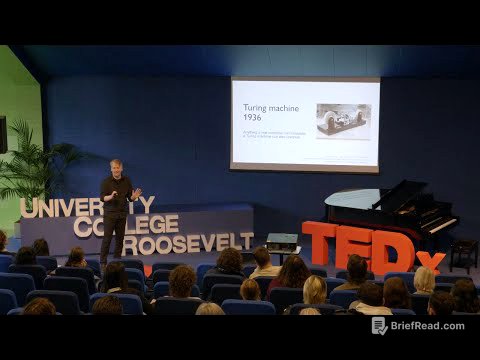TLDR;
Alright, so this lecture is all about diving deep into the structure of the atom, innit? We're gonna bust the myth that atoms are indivisible, thanks to some cool experiments by scientists. We'll be looking at electrons, protons, and neutrons, and how they were discovered. Plus, we'll check out different atomic models, quantum numbers, electronic configuration, and all that jazz.
- Discovery of fundamental particles like electrons, protons, and neutrons.
- Atomic models proposed by Thomson and Rutherford.
- Quantum numbers and their significance.
- Electronic configuration and related rules.
Introduction [0:00]
The lecture starts with a pep talk about how challenges are just fuel for victory. Then, it's straight into the topic: the structure of the atom. It's mentioned that we're moving on from basic chemistry concepts to something more complex. The whole lecture will be centered around the atom.
Discovery of Fundamental Particles [1:24]
Dalton's atomic theory said atoms are the smallest, indivisible particles. But hold up! Scientists did some experiments that proved atoms are actually made of three fundamental particles: electrons, protons, and neutrons. So, the lecture will focus on how these particles were discovered.
Discovery of Electrons (Cathode Rays) [2:02]
The discovery of electrons is also known as the study of cathode rays. William Crookes took a Crookes tube, about 60 cm long, and put two electrodes inside. He used hydrogen gas in the tube, applied high voltage (around 10,000 volts), and maintained low pressure. Initially, at 1 atm pressure, no current flowed. But when the pressure was reduced to 1 mm, current started flowing, and a colored glow was seen. When the pressure was further reduced to 0.01 mm, the cathode rays weren't visible. So, they used a perforated anode, and a greenish glow was observed on the other end.
Properties of Cathode Rays [9:08]
JJ Thomson compared cathode rays to electrons and found their properties were similar. Cathode rays travel in straight lines, proven by the sharp shadows they cast when an object is placed in their path. They're made of material particles and possess kinetic energy, shown by how they rotate a paddle wheel placed in their path. Cathode rays carry a negative charge, as they're attracted to the positive plate in an electric field. They're also deflected by a magnetic field, further confirming their negative charge. Plus, they have a heating effect, ionize gases, produce X-rays when striking hard metals, affect photographic plates, and have a penetrating effect, passing through thin metal foils.
Charge to Mass Ratio (J.J. Thomson's Experiment) [15:37]
JJ Thomson calculated the charge-to-mass ratio by applying electric and magnetic fields. He used different electrodes and gases but found the ratio was the same: 1.76 x 10^8 coulombs per gram. The deviation of rays depended on the magnitude of the negative charge, the mass of the particle, and the strength of the magnetic field. The specific charge of an electron is independent of the nature of the gas.
Millikan's Oil Drop Experiment [20:47]
To find the mass of an electron, Millikan did the oil drop experiment. Oil droplets were sprayed using an atomizer and allowed to fall through a hole between two charged plates. X-rays ionized the air, and electrons attached to the oil droplets. By balancing electrostatic and gravitational forces, they calculated the charge and mass of electrons. The mass came out to be 9.11 x 10^-28 grams, about 1/1837th of the mass of hydrogen. An electron is a fundamental particle with a negative charge and a mass of about 1/1837th the mass of hydrogen.
Discovery of Protons (Canal Rays/Anode Rays) [27:31]
Protons were discovered by Goldstein using a Crookes tube. Unlike the electron discovery setup, the cathode and anode were on opposite sides. Cathode rays (electrons) travel from cathode to anode, while anode rays (protons) travel from anode to cathode. Anode rays are positively charged particles.
Properties of Protons [29:32]
Protons carry a positive charge, produce a heating effect, and travel in straight lines. They're deflected by magnetic fields and possess kinetic energy. Unlike electrons, the specific charge of protons depends on the nature of the gas. The charge of a proton is +1.6 x 10^-19 coulombs, the same magnitude as an electron but positive. The mass of a proton is about the same as a hydrogen atom, 1.6 x 10^-24 kg. A proton is a fundamental particle with a positive charge and a mass similar to a hydrogen atom.
Discovery of Neutron [37:19]
Chadwick discovered the neutron by bombarding beryllium with alpha particles (helium). This produced neutrons. Neutrons are neutral, meaning they have no charge, and their mass is similar to that of a proton. A neutron is a fundamental particle with no charge and a mass equal to that of a hydrogen atom.
Atomic Models: Thomson's Model [41:10]
Thomson compared the atom to a watermelon or raisin pudding. He said the atom is a positively charged sphere with electrons embedded in it, like seeds in a watermelon. The atom is neutral because the total positive charge equals the total negative charge. However, this model failed because it couldn't explain Rutherford's scattering experiments.
Rutherford's Scattering Experiment [44:17]
Rutherford's experiment involved firing alpha particles at a gold foil. Most particles passed straight through, some were deflected at angles, and a few bounced back. This showed that atoms have mostly empty space, a positively charged center (nucleus), and that the nucleus is heavy.
Observations and Conclusions from Rutherford's Experiment [48:10]
The observations from Rutherford's experiment led to these conclusions: Atoms have mostly empty space (99.9% of rays pass straight). The center of the atom is positively charged (some rays are deflected by small angles). The nucleus is heavy (very few rays are reflected back).
Components of Atom (Nucleus and Extra Nuclear Part) [51:39]
Atoms consist of two parts: the nucleus and the extra nuclear part. The nucleus is positively charged, located at the center, and contains neutrons and protons. The extra nuclear part contains electrons that revolve around the nucleus.
Atomic Number and Mass Number [54:41]
Atomic number (Z) is the number of protons in an atom. Mass number (A) is the sum of neutrons and protons. In a neutral atom, the number of protons equals the number of electrons. The representation of an element X with atomic number Z and mass number A is written as AZX.
Calculating Number of Protons, Neutrons and Electrons [59:30]
Examples are given to calculate the number of electrons, protons, and neutrons in ions like sulfate (SO₄²⁻) and phosphate (PO₄³⁻). For ions, negative charges mean adding electrons, and positive charges mean subtracting electrons.
Isotopes, Isobars, Isotones and Isoelectronic Species [1:10:02]
Isotopes are atoms of the same element with the same atomic number but different mass numbers (e.g., hydrogen isotopes). Isobars are atoms of different elements with the same mass number but different atomic numbers (e.g., argon, potassium, calcium). Isotones are atoms with the same number of neutrons. Isoelectronic species have the same number of electrons (e.g., Na⁺, Mg²⁺, Al³⁺).
Practice Problems [1:16:42]
Examples are provided to calculate the number of protons, neutrons, and electrons for oxygen, sodium ion, and bromine.
Dual Nature of Light [1:20:33]
Light has a dual nature: wave nature and particle nature. In wave nature, light travels as an electromagnetic wave with electric and magnetic components perpendicular to the direction of propagation. In particle nature, light travels as small energy packets called quanta or photons.
Wave Nature of Light: Characteristics of a Wave [1:24:53]
Key wave characteristics include wavelength (distance between two consecutive crests or troughs), frequency (number of waves passing in one second, measured in Hertz), wave number (number of waves in a unit cycle), and amplitude (height of the crest or trough).
Particle Nature of Light: Planck's Theory [1:29:25]
Planck's theory states that energy is absorbed or released in small packets called quanta. For light, these packets are called photons. The energy of a photon is directly proportional to its frequency (E = hν), where h is Planck's constant (6.62 x 10^-34 joule-seconds).
Bohr's Model of Atom [1:30:52]
Bohr's model states that electrons revolve around the nucleus in specific circular paths. Electrons don't radiate energy during revolution but only when jumping between energy levels. When an electron absorbs energy, it jumps to a higher orbit; when it comes back, it radiates energy. Only orbits with orbital angular momentum as an integral multiple of h/2π are allowed.
Mathematical Treatment of Bohr Model [1:33:46]
The lecture covers formulas for radius, velocity, and total energy of an electron. It also explains how to establish relationships between radius and energy for the same and different elements.
Photoelectric Effect [1:44:09]
The photoelectric effect is the emission of electrons from a metal surface when light (photons) is incident on it. The energy of the incident photon (hν) equals the work function (energy required to release the electron) plus the kinetic energy of the emitted electron.
Stopping Potential [1:47:11]
Stopping potential is the minimum voltage applied to stop the ejected electron. The work done to stop the electron (eVs) equals the kinetic energy of the electron.
Spectra and Hydrogen Spectrum [1:48:37]
Spectra are records of the intensity of light transmitted or scattered by a molecule as a function of frequency or wavelength. The hydrogen spectrum shows different spectral lines (Lyman, Balmer, Paschen, Brackett, Pfund, and Humphrey series) corresponding to electron transitions between energy levels.
Spectral Series and Related Formulas [1:53:09]
The lecture provides formulas for calculating the number of possible lines produced during electron transitions and the relationship between wavelength, wave number, and energy levels.
Limitations of Bohr's Model [1:55:06]
Bohr's model couldn't explain the Zeeman effect (splitting of spectral lines in a magnetic field), the Stark effect (splitting in an electric field), the dual nature of matter, or Heisenberg's uncertainty principle.
Heisenberg's Uncertainty Principle [1:57:15]
Heisenberg's uncertainty principle states that it's impossible to simultaneously measure the exact position and momentum of a microscopic particle. The uncertainty in position (Δx) times the uncertainty in momentum (Δp) is greater than or equal to h/4π.
Shapes of Orbitals: s, p and d Orbitals [1:58:56]
The probability of finding an electron determines the shape of an orbital. S orbitals are spherical and non-directional. P orbitals are dumbbell-shaped and have three types: px, py, and pz. D orbitals are double dumbbell-shaped and have five types: dxy, dyz, dzx, dx²-y², and dz².
Axial and Non-Axial d Orbitals [2:10:37]
D orbitals are classified into axial (dx²-y² and dz²) and non-axial (dxy, dyz, and dzx) types. Axial orbitals have lobes on the axes, while non-axial orbitals have lobes in between the axes.
Quantum Numbers [2:18:51]
Quantum numbers are a set of four numbers that determine the address, shape, and energy of an electron. These include the principal quantum number (n), azimuthal quantum number (l), magnetic quantum number (m), and spin quantum number (s).
Principal Quantum Number (n) [2:21:12]
The principal quantum number (n) represents the shell number and provides information about the shell, radius, distance, velocity, potential energy, and total energy. The maximum number of electrons in a shell is 2n².
Azimuthal Quantum Number (l) [2:29:00]
The azimuthal quantum number (l) represents the subshell and is also known as the subsidiary or angular quantum number. The value of l ranges from 0 to n-1. If l=0, it's an s subshell; if l=1, it's a p subshell; if l=2, it's a d subshell; if l=3, it's an f subshell.
Formulas Related to Azimuthal Quantum Number [2:31:12]
The number of orbitals in a subshell is 2l+1, and the number of electrons in a subshell is 2(2l+1). The azimuthal quantum number also explains orbital angular momentum.
Magnetic Quantum Number (m) [2:37:21]
The magnetic quantum number (m) explains the Zeeman effect and the orientation of electrons in space. The value of m ranges from -l to +l.
Table Summarizing Quantum Numbers [2:40:07]
A table summarizes the values of l and m for s, p, d, and f orbitals.
Spin Quantum Number (s) [2:47:11]
The spin quantum number (s) represents the spin of an electron, which can be either clockwise (+½) or anti-clockwise (-½). The magnetic moment is calculated using the formula √(n(n+2)) Bohr magneton, where n is the number of unpaired electrons.
Nodes and Anti-Nodes [2:49:59]
A node is a region where the probability of finding an electron is zero. There are two types of nodes: radial nodes and angular nodes. The formula for radial nodes is n-l-1, for angular nodes is l, and for total nodes is n-1.
Nodal Plane [2:52:52]
A nodal plane is a plane where the probability of finding an electron is zero. For px, the nodal plane is yz; for py, it's xz; and for pz, it's xy.
Table Summarizing Nodes and Nodal Planes [2:55:20]
A table summarizes the radial nodes, angular nodes, total nodes, and nodal planes for various orbitals.
Electronic Configuration: Aufbau Principle [3:07:41]
The Aufbau principle states that when writing electronic configurations, the lowest energy orbitals should be filled first. The lecture provides an energy diagram to help determine the order in which orbitals should be filled.
n+l Rule [3:14:56]
The n+l rule is used to determine the energy of an orbital. The orbital with the lower n+l value has lower energy. If the n+l values are the same, the orbital with the lower n value has lower energy.
Pauli's Exclusion Principle [3:17:20]
Pauli's exclusion principle states that no two electrons in an atom can have the same value for all four quantum numbers. In the same orbital, electrons always accommodate in opposite spins.
Hund's Rule of Maximum Multiplicity [3:20:43]
Hund's rule of maximum multiplicity states that electrons are distributed among the orbitals of a subshell in such a way as to give the maximum number of unpaired electrons with parallel spins. Fully filled orbitals are more stable due to spherical symmetry, and half-filled orbitals are more stable than other electronic configurations due to maximum spin multiplicity.
Examples of Electronic Configuration [3:25:19]
Examples are provided for writing the electronic configurations of hydrogen, helium, lithium, sodium, chromium, and copper. Chromium and copper have abnormal electronic configurations due to the stability of half-filled and fully filled d orbitals.









